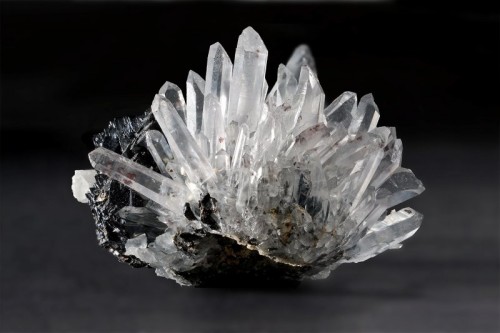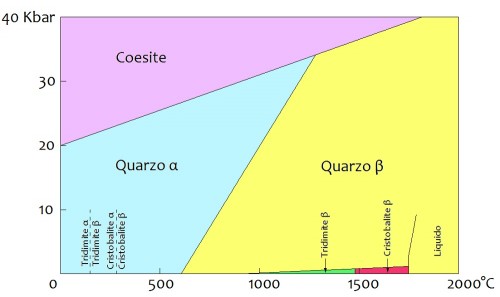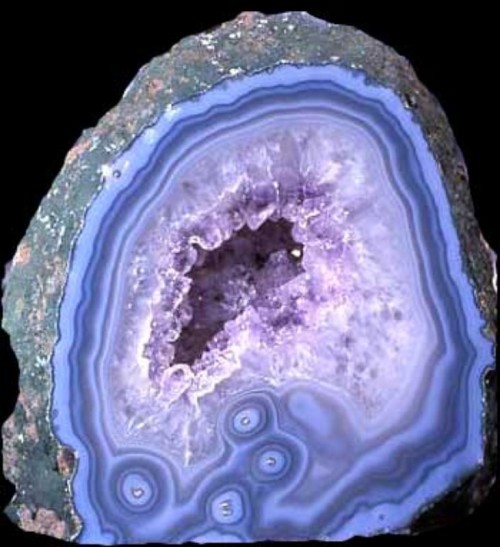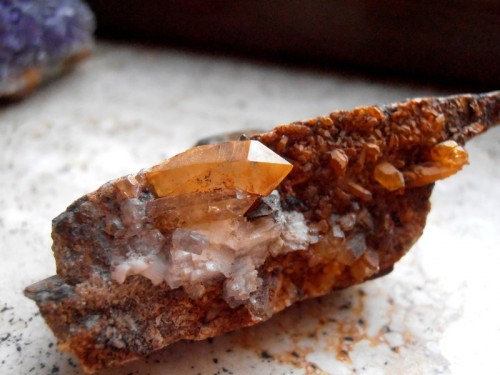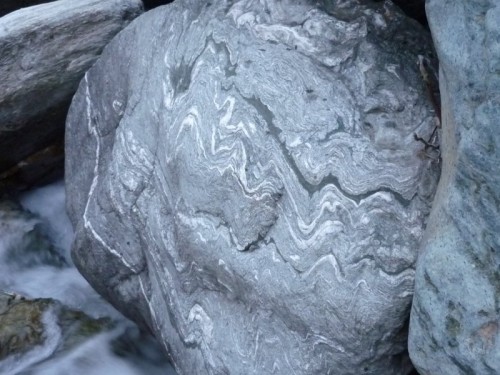Luca Inzerillo 31 agosto 2011
Il quarzo, oltre ad essere uno dei minerali più diffusi nella crosta terrestre (ne costituisce il 12% in volume), è sicuramente uno dei più noti minerali esistenti. Ognuno di noi lo avrà ammirato in qualche museo nella limpida e trasparente forma dei cristalli di rocca, o più semplicemente avrà notato le sue bianche vene all’interno delle rocce durante una passeggiata in montagna. In effetti la sua abbondanza si riflette nella sua presenza in moltissime rocce ed in una grandissima varietà di forme dei suoi cristalli.
Figura 1 – Cristallo di Quarzo. Perù. Immagine tratta da wikipedia.com
Ma forse non tutti sanno che il quarzo è una delle tante fasi polimorfiche della silice.
Per polimorfismo si intende la possibilità che un composto chimico cristallizzi in diverse strutture. Infatti, il composto SiO2, noto come silice, presenta ben 22 differenti fasi di cristallizzazione.
La fase più nota e diffusa in natura è il quarzo-α romboedrico, componente abbondante delle rocce magmatiche acide (cioè ricche di silice), sia intrusive che effusive. Sicuramente il quarzo-α di queste rocce è cristallizzato inizialmente come quarzo-β, ovvero la fase esagonale stabile a più alta temperatura; tuttavia, durante il raffreddamento di queste rocce, tutto il quarzo-β si trasforma immediatamente in quarzo-α non appena la temperatura scende al di sotto dei 573°C, limite di stabilità tra quarzo-α e quarzo-β a pressione ambiente.
Il quarzo- α si presenta in molteplici forme: da cristalli ben formati, anche di dimensioni enormi (svariate decine di kg), a masse microcristalline compatte come le quarziti. I cristalli sono generalmente bianchi, ma non mancano le varietà trasparenti (i cristalli di rocca) o dai colori più vivaci, dal violetto dell’Ametista al giallo del Citrino.
Poi vi sono le strutture della Tridimite e della Cristobalite, stabili a pressioni molto basse nella fase β, mentre le fasi α, che non presentano un vero e proprio campo di stabilità, si formano se le corrispondenti fasi β vengono portate per raffreddamento nel campo di stabilità del quarzo-α.
Infine vi sono le fasi di alta ed altissima pressione: la Coesite, monoclina e con densità maggiore di quarzo, tridimite e cristobalite, e la Stishovite, tetragonale con il Silicio in insolita coordinazione ottaedrica, stabile al di sopra di 140 kbar e per questo non presente nel diagramma qui riportato.
Figura 2 – Diagramma P/T della Silice. Da Sosman, ridisegnato. Da notare il passaggio quarzo-α quarzo-β a temperature crescenti all’aumentare della pressione ed il passaggio a bassa pressione da fasi β a fasi α di cristobalite e tridimite per raffreddamento dei cristalli.
Ma in natura cosa possiamo osservare?
In ambiente magmatico il quarzo rappresenta uno dei maggiori costituenti delle rocce, in particolar modo di quelle acide intrusive (graniti, granodioriti e tonaliti) ed effusive (porfidi, rioliti). Cristallizza direttamente dal magma nella fase quarzo-β esagonale, per poi passare alla fase quarzo-α raffreddandosi. Si rinviene in cristalli e masse microcristalline compatte generalmente bianche o variamente colorate se sono presenti inclusi di altri ioni o materiale estraneo. Particolarmente belli sono i cristalli delle pegmatiti. La tridimite e la cristobalite si rinvengono solo in alcune lave acide cristallizzate rapidamente e a bassa pressione, cioè in condizioni tali da impedire la trasformazione in quarzo.
I quarzi di genesi idrotermale nascono già romboedrici (la temperatura è inferiore ai 573°C). Possono essere trasparenti e limpidi, come i cristalli di rocca, o estremamente colorati, come l’ametista in lilla, il quarzo citrino nei toni del giallo e il quarzo affumicato dal bruno al nero. Le masse microcristalline e compatte originate da deposizioni idrotermali di bassa temperatura, prendono il nome generico di calcedonio, che diviene agata se la massa è zonata e presenta bande di differenti colori o, ancora, corniola se è di colore rosso.
Figura 3 – La sezione di un geode del cretacico mostra un agata blu con al centro dei cristalli di ametista. Immagine tratta da ipanemarovis.com
In ambiente sedimentario esistono due grandi processi utili per la formazione di masse quarzose: il primo consiste nell’alterazione e nello smantellamento di rocce preesistenti ad opera degli agenti esogeni, ai quali solo i cristalli di quarzo sono in grado di resistere. Questi, accumulati dal trasporto nell’alveo di un fiume o sul fondo del mare andranno a costituire una sabbia quarzosa che, con il tempo, potrà litificare e divenire un’arenaria quarzosa, ovvero una roccia sedimentaria costituita da clasti di quarzo uniti da cementi di vario genere (carbonati, argille o quarzo).
Il vero quarzo “sedimentario” è, invece, di precipitazione chimica e biologica, solitamente in ambiente marino, così come avviene per il carbonato di calcio. Tuttavia, mentre le acque marine sono normalmente sovra sature di carbonati e fosfati di calcio ciò non è vero per la silice di cui sono generalmente sottosature. Così accade che la sedimentazione biologica di scheletri di radiolari, diatomee e spicole di spugne non è sufficiente a far precipitare grandi masse silicee. Queste ultime si formano in concomitanza di grandi eruzioni sottomarine che, portando in soluzione notevoli quantità di silicati, saturano le acque marine e consentono la precipitazione di silice. Così accade che carbonati e silicati precipitano insieme; da questo sedimento misto, durante la diagenesi, le masse silicee si segregano da quelle carbonatiche a formare strati ben distinti di calcari marini e di silice. Gli strati silicei prendono il nome di selci, microcristallini e dall’aspetto giallo bruno, se formano strati sottili e di diaspri, quando danno potenti strati microcristallini e coloratissimi, dal giallo, al rosso, all’azzurro ed al grigio.
Figura 3 – Cristalli di quarzo all’interno della formazione del Pizzo del Diavolo.
In ambiente metamorfico il quarzo è ancora molto frequente. È stabile dai bassi agli alti gradi metamorfici, dalle filladi alle eclogiti, ed è facilmente mobilizzato in vene quarzose ed in grandi masse di segregazione. Nel processo di anatessi (fusione parziale di una roccia) è il primo minerale a fondere e tra i primi a ricristallizzare. Tuttavia, non esistono grandi elementi distintivi tra un quarzo magmatico ed uno metamorfico.
Figura 4 – Vene di quarzo in uno gneiss della Valmalenco.
Infine, nei crateri di impatto meteorico è possibile osservare le fasi di alta ed altissima pressione della silice, note come coesite e stishovite: in questi luoghi l’enorme pressione sviluppata dall’impatto ha trasformato il quarzo-α preesistente nelle fasi stabili alle alte pressioni.
